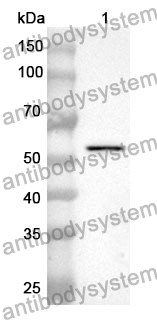Robust Serum Proteomic Signatures of APOE2., PMID:40501769
Multi-omics landscapes reveal heterogeneity in long COVID patients characterized with enhanced neutrophil activity., PMID:39135185
Prevalence of Inflammatory Pathways Over Immuno-Tolerance in Peripheral Blood Mononuclear Cells of Recent-Onset Type 1 Diabetes., PMID:35058920
Artificial Neural Networks Predicted the Overall Survival and Molecular Subtypes of Diffuse Large B-Cell Lymphoma Using a Pancancer Immune-Oncology Panel., PMID:34945004
Functional study of acetaldehyde dehydrogenase 1 (ALDH1) in keratinocytes: microarray integrating bioinformatics approaches., PMID:32189581
Neutrophil Extracellular Traps Induce Endothelial Cell Activation and Tissue Factor Production Through Interleukin-1α and Cathepsin G., PMID:29976772
Insulin-like growth factor-1 signaling is responsible for cathepsin G-induced aggregation of breast cancer MCF-7 cells., PMID:28544544
Cathepsin G Controls Arterial But Not Venular Myeloid Cell Recruitment., PMID:27660294
An agonist antibody that blocks autoimmunity by inducing anti-inflammatory macrophages., PMID:26481307
Novel staphylococcal glycosyltransferases SdgA and SdgB mediate immunogenicity and protection of virulence-associated cell wall proteins., PMID:24130480
Carcinoma mucins trigger reciprocal activation of platelets and neutrophils in a murine model of Trousseau syndrome., PMID:21860019
Cathepsin G-mediated enhanced TGF-beta signaling promotes angiogenesis via upregulation of VEGF and MCP-1., PMID:19646811
Co-localization of tryptase and cathepsin-G in mast cells in cutaneous mastocytosis., PMID:19250736
Modulation of tissue factor and tissue factor pathway inhibitor-1 by neutrophil proteases., PMID:19132232
A hydrophobic patch on proteinase 3, the target of autoantibodies in Wegener granulomatosis, mediates membrane binding via NB1 receptors., PMID:18854317
The defensive role of lysozyme in human gingiva in inflammatory periodontal disease., PMID:18752566
The cleavage of neutrophil leukosialin (CD43) by cathepsin G releases its extracellular domain and triggers its intramembrane proteolysis by presenilin/gamma-secretase., PMID:18586676
Neutrophil secretion products pave the way for inflammatory monocytes., PMID:18490516
4-Hydroxy-2-nonenal-modified glyceraldehyde-3-phosphate dehydrogenase is degraded by cathepsin G., PMID:18037126
Anti-myeloperoxidase and anti-cathepsin G antibodies in sulphonamide hypersensitivity., PMID:17976219
Antibodies to selected minor target antigens in patients with anti-neutrophil cytoplasmic antibodies (ANCA)., PMID:17614969
Neutrophil interaction with the hemostatic system contributes to liver injury in rats cotreated with lipopolysaccharide and ranitidine., PMID:17505017
Cathepsin-G interferes with clearance of Pseudomonas aeruginosa from mouse lungs., PMID:17211136
N-terminal proteolytic processing by cathepsin G converts RANTES/CCL5 and related analogs into a truncated 4-68 variant., PMID:16963625
Defensins- and cathepsin G-ANCA in systemic lupus erythematosus., PMID:16900373
Mast cells and neutrophils proteolytically activate chemokine precursor CTAP-III and are subject to counterregulation by PF-4 through inhibition of chymase and cathepsin G., PMID:16317101
Induction of multicellular 3-D spheroids of MCF-7 breast carcinoma cells by neutrophil-derived cathepsin G and elastase., PMID:16128741
Interference of neutrophil-platelet interaction by YC-1: a cGMP-dependent manner on heterotypic cell-cell interaction., PMID:16112105
Cytokine production by skin-derived mast cells: endogenous proteases are responsible for degradation of cytokines., PMID:16081839
Serine protease cathepsin G regulates adhesion-dependent neutrophil effector functions by modulating integrin clustering., PMID:15963783
Autoantibodies to bactericidal/permeability-increasing protein and cathepsin G in systemic sclerosis., PMID:15229985
Detection rate and antigenic specificities of antineutrophil cytoplasmic antibodies in chinese patients with clinically suspected vasculitis., PMID:15138182
Thrombin activates envelope glycoproteins of HIV type 1 and enhances fusion., PMID:15109955
Searching for genes involved in arteriosclerosis: proteomic analysis of cultured human umbilical vein endothelial cells undergoing replicative senescence., PMID:15004419
[Prevalence and clinical significance of cathepsin G antibodies in systemic sclerosis]., PMID:14872225
Molecular cloning, expression and characterization of a serine proteinase inhibitor gene from Entamoeba histolytica., PMID:14698428
Monoclonal LYM-1 antibody-dependent cytolysis by human neutrophils exposed to GM-CSF: auto-regulation of target cell attack by cathepsin G., PMID:14525961
Involvement of corneal nerves in the progression of keratoconus., PMID:12957150
Bactericidal/permeability-increasing protein and cathepsin G are the major antigenic targets of antineutrophil cytoplasmic autoantibodies in systemic sclerosis., PMID:12784398
Proteinase-activated receptor-2 and human lung epithelial cells: disarming by neutrophil serine proteinases., PMID:12594060
Processing of the human transferrin receptor at distinct positions within the stalk region by neutrophil elastase and cathepsin G., PMID:12222675
Modulation of cathepsin G expression in severe atopic dermatitis following medium-dose UVA1 phototherapy., PMID:12204095
Dipeptidyl peptidase I activates neutrophil-derived serine proteases and regulates the development of acute experimental arthritis., PMID:11827996
Activation of progelatinase A (MMP-2) by neutrophil elastase, cathepsin G, and proteinase-3: a role for inflammatory cells in tumor invasion and angiogenesis., PMID:11598905
Antibody testing for ulcerative colitis--more letters?, PMID:11467665
Differential effects of apoptotic versus lysed cells on macrophage production of cytokines: role of proteases., PMID:11359844
The neutrophil granule protein cathepsin G activates murine T lymphocytes and upregulates antigen-specific IG production in mice., PMID:11352647
Polymorphonuclear leucocytes mediate endogenous thrombus lysis via a u-PA-dependent mechanism., PMID:11328284
Neutrophil proteases can inactivate human PAR3 and abolish the co-receptor function of PAR3 on murine platelets., PMID:11307827
Antineutrophil cytoplasmic antibodies (ANCAs) in patients with inflammatory bowel disease show no correlation with proteinase 3, lactoferrin, myeloperoxidase, elastase, cathepsin G and lysozyme: a Singapore study., PMID:11269973


